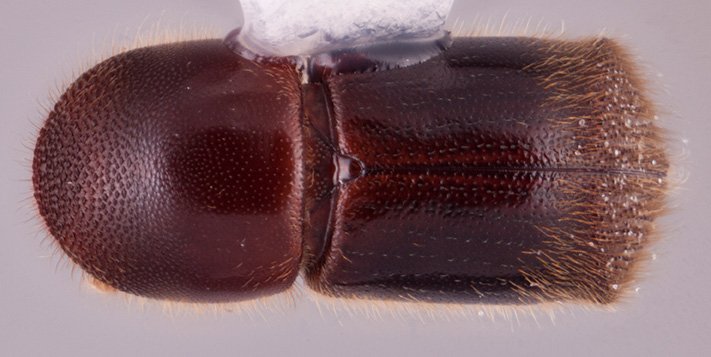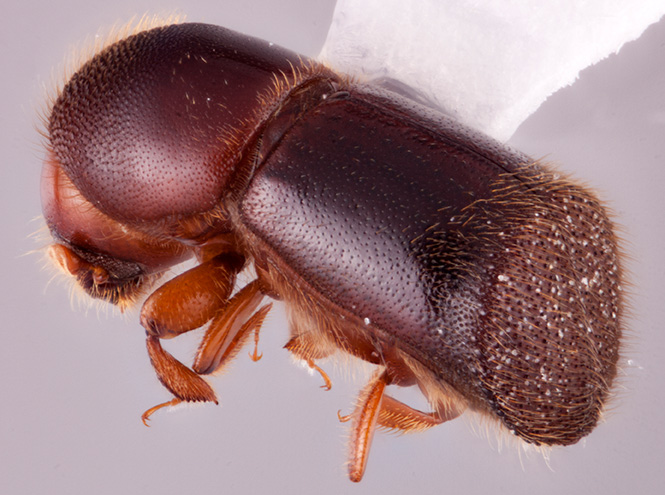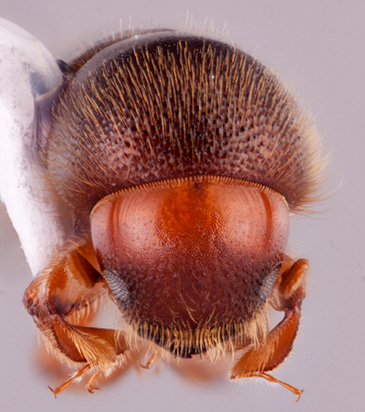Cyclorhipidion circumcisum
|
Cyclorhipidion circumcisum lateral; R.K. Osborn |
|
Cyclorhipidion circumcisum dorsal; R.K. Osborn |
|
Cyclorhipidion circumcisum declivity; R.K. Osborn |
|
Cyclorhipidion circumcisum frontal; R.K. Osborn |
Taxonomic history
Xyleborus circumcisus Sampson, 1921: 30.
Cyclorhipidion circumcisum (Sampson): Wood and Bright, 1992: 698.
Synonyms
Xyleborus subobtusus Schedl, 1942a: 192. Beaver, 2011: 283.
Diagnosis
3.3−3.5 mm long (mean = 3.43 mm; n = 5); 2.54−2.83 times as long as wide. This species can be distinguished by the large size; elytralelytral:
pertaining to the elytra
declivitydeclivity:
downward slope of either the pronotum or elytra
 obliquely truncatetruncate:
obliquely truncatetruncate:
appearing cut off or suddenly shortened , strongly shagreenedshagreened:
, strongly shagreenedshagreened:
covered with a closely-set roughness, like shark skin  and dull; pronotumpronotum:
and dull; pronotumpronotum:
the dorsal surface of the thorax
longer than wide and basic from dorsaldorsal:
of or relating to the upper surface; opposite of ventral
 view (type 2); declivitaldeclivital:
view (type 2); declivitaldeclivital:
pertaining to the elytral declivity
interstriae densely covered in multiseriate rows of tuberclestubercle:
a small knob-like or rounded protuberance of the exoskeleton .
.
May be confused with
Cyclorhipidion amasoides, C. amputatum, C. muticum, C. truncaudinum, C. umbratum, all of which are large and have an obliquely truncateobliquely truncate:
nearly truncate but rounded not flat in lateral view
 or truncatetruncate:
or truncatetruncate:
appearing cut off or suddenly shortened declivity
declivity
Distribution
China (Yunnan), Indonesia (Java, Sumatra), East & West Malaysia, Philippines, Thailand
Host plants
The species has a strong preference for Fagaceae (Castanopsis, Lithocarpus, Quercus) (Browne 1961bBrowne 1961b:
Browne FG. 1961b. The biology of Malayan Scolytidae and Platypodidae. Malayan Forest Records 22: 1-255.). There are single records from Canarium (Burseraceae) and an unidentified tree of the same family (Browne 1986Browne 1986:
Browne FG. 1986. Bark beetles and ambrosia beetles (Coleoptera, Scolytidae, and Platypodidae) intercepted at Japanese ports, with descriptions of new species, XIII. Kontyucirc; 54: 89-99., Ohno 1990Ohno 1990:
Ohno S. 1990. The Scolytidae and Platypodidae (Coleoptera) from Borneo found in logs at Nagoya port 1. Research Bulletin of the Plant Protection Service, Japan 26: 83-94.).
DNA data
Sequences available for COI and CAD.
COI: MN199574
CAD: MN199591





